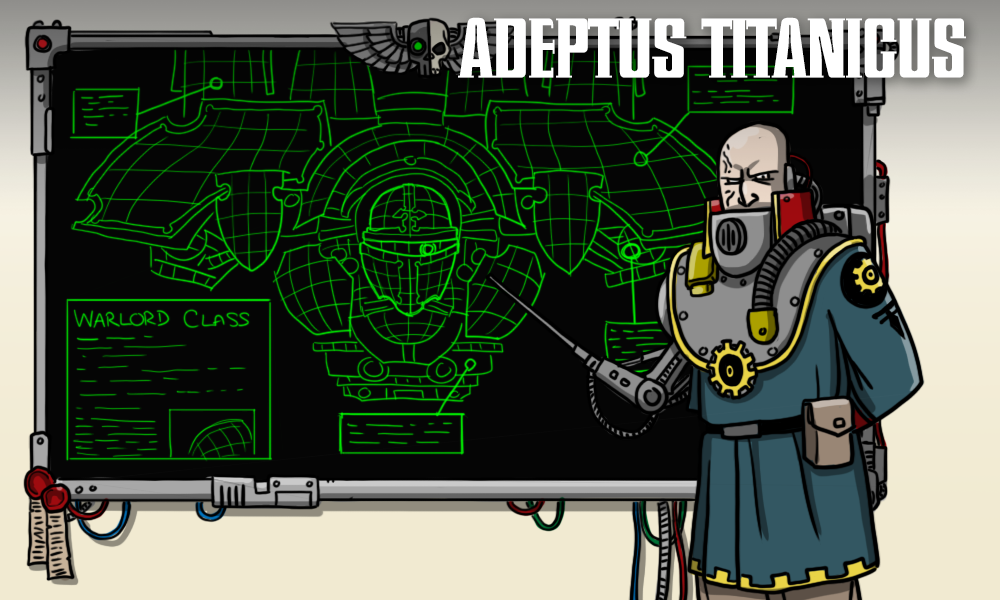Welcome back to Goonhammer’s series for aspiring Titan Principes. We here at Goonhammer’s own Collegia Titanica know that Adeptus Titanicus can seem intimidating to players unfamiliar with its particular quirks, but this series aims to equip you with everything you’ll need to play out epic clashes on the battlefields of the far future with your very own Titan Battlegroup. In this series, we’ll be taking a more in-depth look at the various Legios of the Collegia Titanica – exploring their origins and how to use them on the tabletop, from maniple selection and their loadouts, through to how to command them on the field of battle to secure ultimate victory.
We’ve talked before about Titanic melee, but what about ranged combat? After all, the vast majority of the weapons you can choose from in Adeptus Titanicus don’t have the Melee trait. To that end, we’re here today to run through some of the basics of the Combat Phase in Adeptus Titanicus.
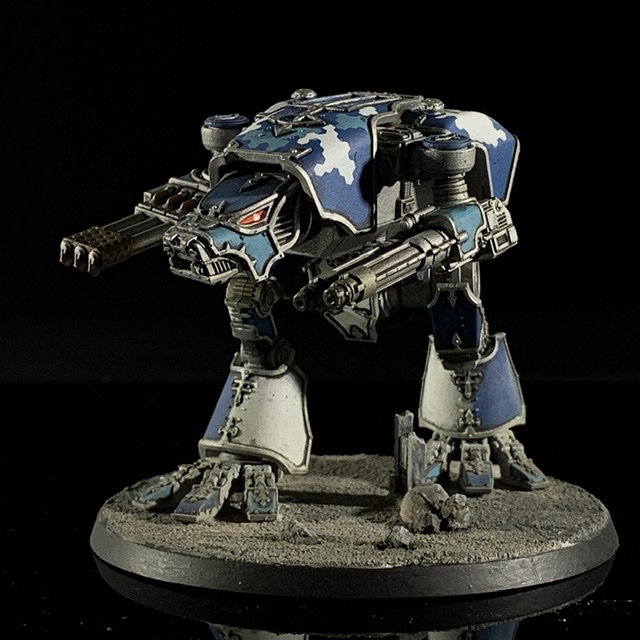
Titanic Combat in Three Easy Steps
We’ve covered it before, but for most ranged-focused battlegroups, there are three phases to bringing down an enemy engine:
- Collapsing Voids: A Titan’s void shields are incredibly powerful and can deflect firepower that would destroy any lesser platform in an instant – even the mighty Belicosa volcano cannon can’t pierce an operational void shield. You’ll need to overload them in order to be able to put any damage on the actual Titan.
-
- If you want a target’s voids gone right now, look no further than the vulcan megabolter. At strength 4, it’s just barely strong enough to force void saves, and its Rapid trait means that each one you fire will average 6 hits if fired from within 8” (accounting for the +1 bonus to hit from Short range modifier and assuming there’s no negative to hit on the target). Don’t expect it to do much to armor, though.
- Cracking Armor: Of course, once your target’s voids have collapsed, there’s still the actual armor to deal with, and the Collegia Titanica doesn’t mess around when it comes to protection. You’re going to need some serious firepower to break open that armor and expose your enemy’s vulnerable inner mechanisms.
-
- The Belicosa volcano cannon is the archetypal anti-armor weapon in Titanicus. The Blast trait means that every successful hit roll will result in 2 hits at strength 12, and the fact that you can’t make targeted attacks with it doesn’t hurt quite so much against an undamaged Titan as you don’t particularly care where those hits land.
- The Coup de Grace: Once you’ve opened a hole in your target’s armor, target that gap with everything you’ve got and take it down.
-
- Gatling blasters and macro-gatling blasters are incredible at this – the high shot count and accuracy bonus combine to give you a decent number of shots on target, and re-rolls from the Ordnance trait will minimize the number of hits that don’t convert, especially when targeting locations that have already taken a few points of damage.
These examples aren’t the only weapons that can do well at a particular thing, of course, and the role that a weapon will play in your particular

Loadouts
One of the most common mistakes we see beginning players make when loading out their Titans is building specialist engines rather than generalist ones. For example, if you’re taking a pair of Warhounds, you may find it tempting to build one with a pair of vulcan mega-bolters and the other with a pair of plasma blastguns. The theory here is that when making a Coordinated Strike, you’ll either start with the dual bolter hound into voids then hopefully follow up with dual plasma into armor, or vice versa into a shieldless Titan, using the plasma to crack armor and the bolters to make targeted attacks against vulnerable locations.
That’s not a bad plan, but it has a serious weakeness: what happens when you lose one of the Titans? Lose the dual bolter hound, and you’re left with a hound which will struggle to achieve anything against targets with voids. Worse, if you lose the dual plasma engine, your megabolters will find it nearly impossible to cause harm to anything larger than a Reaver.
If, on the other hand, you split the weapons between the two engines, you’ll lose a bit of effectiveness on most Coordinated Strike attempts, but if one of your Warhounds dies then the other can still threaten an enemy Titan at any phase of the game. No plan survives contact with the enemy, or with any of the myriad of other conditions you’ll find yourself dealing with, such as unruly reactor dice, a strong willed machine spirit, or the battlefield itself. Equipping your Titans to have some measure of flexibility and self-sufficiency will result in lowering the chance of “wasted” activations. The Warbringer often sits in an odd place as well, where generally it’s not doing a whole lot of shield stripping on its own, but is able to pump out lots of damage at range once shields have been dropped.
We aren’t telling you that any particular loadout is bad here though, just that if you equip your titans with only blast weapons, only low-dice high-strength weapons, or only with low-strength high-dice weapons then you’re going to be heavily relying on other Titans or Knights to do some form of heavy lifting for that Titan.
Some Legios will significantly change how you build your Titans, though. For example, Gryphonicus wants to be built for one-on-one duels more than any other Legio, while others like Metalica, Vulcanum, or Venator want to be able to strip shields and then go in hard with a second Titan firing immediately afterwards either as part of a squadron or with Metalica’s Victories Beyond Measure. Legio Defensor will want to focus on long-ranged firepower so they can get as much mileage out of their start-of-game alpha strike potential, while Praesagius does best with weapons that have short range characteristics that are as small as possible so they can take advantage of their improved reliability at long range.
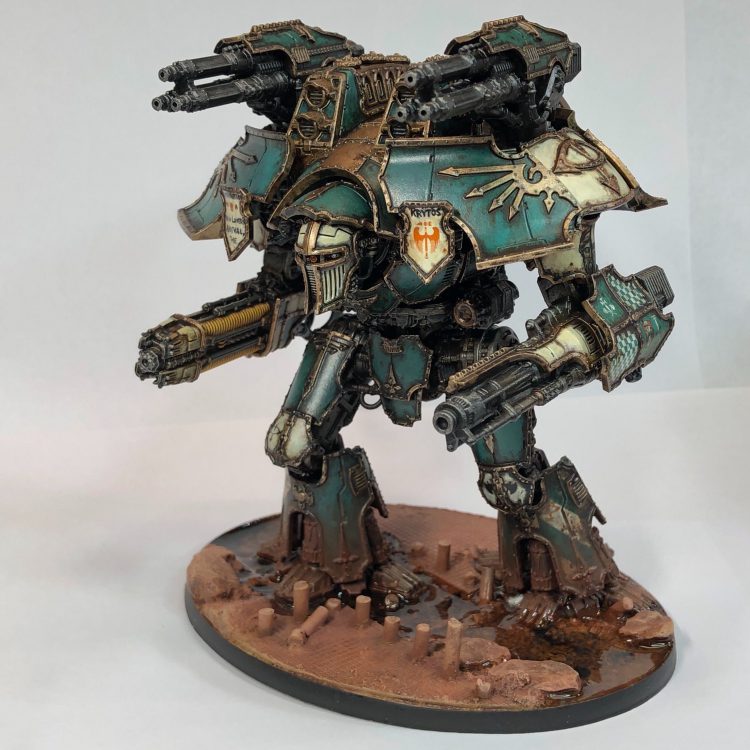
Target Priority
After arming your God-Engines, they need to get into position to unleash their titanic weaponry. At the start of each turn, you should have an idea of what each unit is going to achieve this turn and which Titans are going to engage what. This means that all the way in the command phase you’ll be picking your prey for the turn.
Target selection and priority is one of the most valuable skills in Titanicus, as there is a delicate balance of knowing how much to focus on a single target – too often new players will split their fire too much and find their activations ineffective.
Here’s just a handful of some of the things to consider when picking a target for each of your Titans:
- Positioning – is your target within effective range of your weapons and what is the chance they can dodge your firing arc? Can you get into a flank or rear arc?
- Terrain – is there terrain blocking your shot?
- Void shield status – How many void shield levels are still up? Can this Titan or another drop the voids first?
- Armour and critical damage – If the voids are down, what locations can you actually damage with your weapons? What are the odds of your attack being effective? Don’t waste your shots firing into something you can’t scratch.
- Immediate Threats – is there a Titan with a melee weapon bearing down on you? Maybe try and target that before it hits your lines.
You’ll also need to keep in mind the number of activations you’ve got to work with – if your opponent outnumbers you (and isn’t heavily squadroned), you may not get the opportunity to line up the target you’d prefer to shoot at, as a savvy player will usually delay activating key pieces until later in the phase so they have as much information as possible before they’re forced to commit to a move. In those situations, it often makes sense to focus on the target you’re given even if it’s not the one you’d have chosen in a perfect world – getting an early engine kill will reduce the number of activations your opponent has, which will make it that much harder for them to hide the Titan you’re really after.
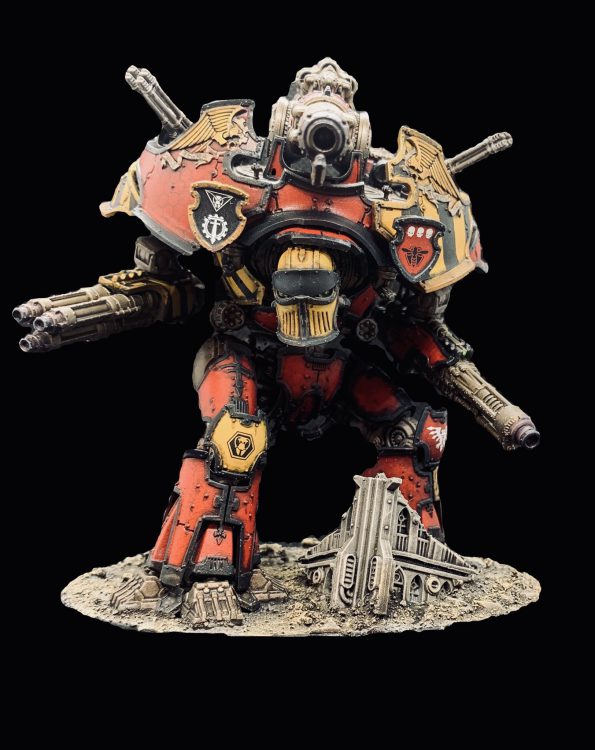
Choosing a Firing Solution
By the end of the movement phase, both you and your opponent have mostly committed your assets, it then becomes time to use them in the Combat phase. Whoever has the initiative for the combat round will get to strike first and choosing which Titan to activate first is yet another balancing act – do you attack with the crippled Titan before it dies or do you return the favour and try and get a quick Engine Kill?
Generally speaking, if you’ve only got a single Titan at risk of being destroyed, you should attack with it first – if you don’t, you may lose an entire activation. Other than that, though, choosing the correct target is a bit of an art, and it’ll take some time to get the hang of it.
One of the most common scenarios you’ll find yourself in will be “can I kill that before it damages/kills me?” The answer to that question will vary wildly. In turns 2-4 there will often be enemy Titans with some shields down and/or some damage taken, but you’ll usually find that you’re dealing with the same problem. That enemy Warlord will probably kill your Reaver without shields if not taken care of, but it was able to repair its shields back to full, so do you have a firing solution that will both take its shields offline and kill it? Likely not, so consider activating the Titan that is soon for death first so that it’s not wasted, or if you do have something that can bring its shields down then once you do consider making aimed-shots for its weapons instead of trying to do some structural damage. Knocking weapons offline is an often-overlooked tactic that can save you, as well as making the next enemy damage control phase include much more difficult decisions.
More fundamentally, the order in which you fire your weapons can make a huge difference. Over time, you’ll develop a sense for which of the three steps of scoring an engine kill each of your weapons is best suited to, and you’ll want to start by firing the weapons that match the state your target is in. For instance, if the target’s voids are up, open up with high shot-count, low strength weapons to force as many saves as possible, and save higher strength weapons in case you cause voids to collapse. If voids are down but the target hasn’t suffered much structure damage, bring your highest strength weapons to bear and blow a hole in armor that you can focus with other weapons later. And if you’re looking at a Titan with a heavily damaged location that’s hovering on the brink of death, unload with a “finisher” weapon or, failing that, repurpose one of your shield-breakers and hope for the best.
One question you may be asking at this point is “What step do lasers fall into?” They’re in a bit of an odd situation, as they’re less effective at any particular step than other weapons you can take, but they can do anything more or less competently. This means that their role in your list will depend on what you’re missing. If you don’t have a lot of megabolters or apocalypse missile launchers, then focus on using their Shieldbane trait to knock down voids. If you’re running low on melta cannons or volcano cannons, they can do reasonably well into armor in a pinch. And while they have lower shot count than a gatling, they can threaten Devastating and Critical hits earlier on the damage track than other weapons. Think about where they fit and how you’ll use them, and they can work out nicely.
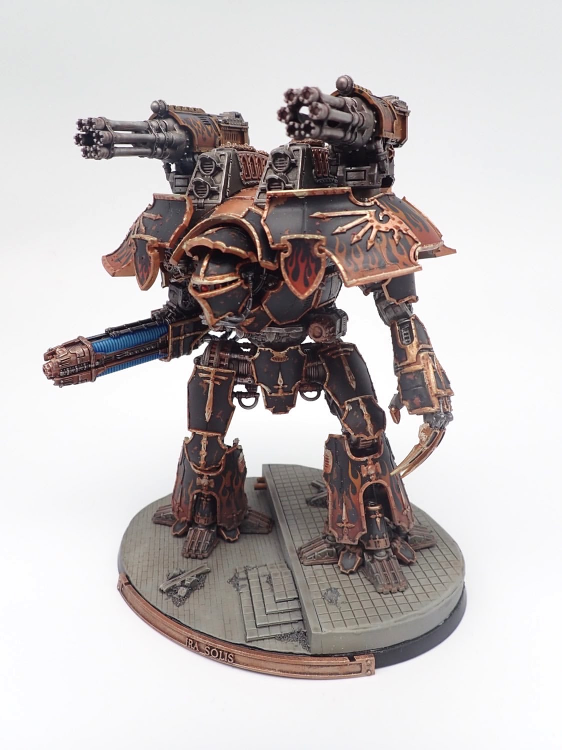
Danger Close
Ranged combat is the bread and butter of Titanicus, and even if you’re planning on running a more aggressive, short-ranged list (Condit: And who wouldn’t?) it’s helpful to have a solid grasp on how your opponent is likely to try to bring you down. As with anything in Titanicus, if you want to be effective at range, you’ll need to have a plan, and the factors we’ve run through here are a solid starting point for your games.
